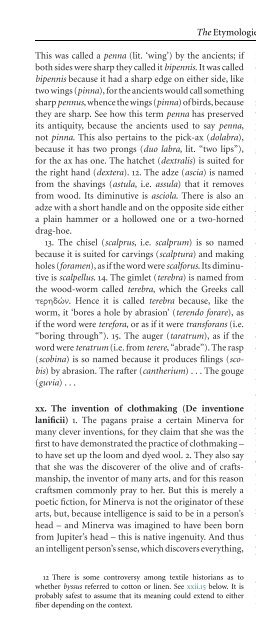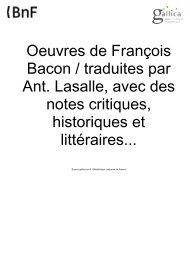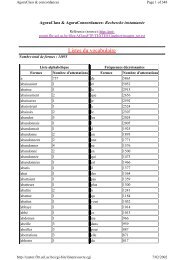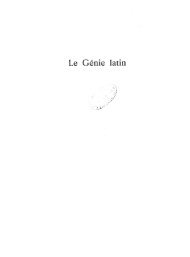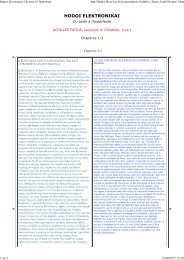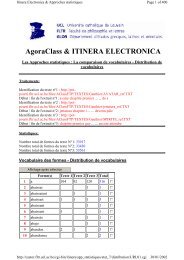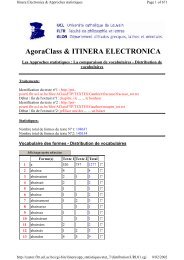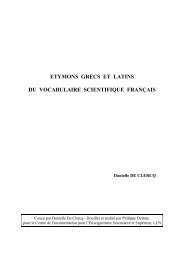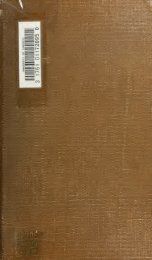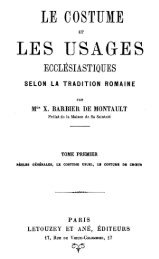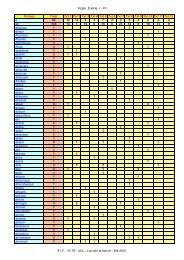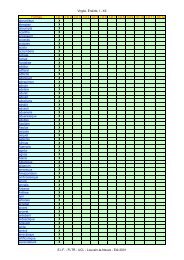The Etymologies of Isidore of Seville - Pot-pourri
The Etymologies of Isidore of Seville - Pot-pourri
The Etymologies of Isidore of Seville - Pot-pourri
You also want an ePaper? Increase the reach of your titles
YUMPU automatically turns print PDFs into web optimized ePapers that Google loves.
This was called a penna (lit. ‘wing’) by the ancients; if<br />
both sides were sharp they called it bipennis.Itwascalled<br />
bipennis because it had a sharp edge on either side, like<br />
two wings (pinna), for the ancients would call something<br />
sharp pennus,whencethe wings (pinna)<strong>of</strong>birds, because<br />
they are sharp. See how this term penna has preserved<br />
its antiquity, because the ancients used to say penna,<br />
not pinna. This also pertains to the pick-ax (dolabra),<br />
because it has two prongs (duo labra, lit. “two lips”),<br />
for the ax has one. <strong>The</strong> hatchet (dextralis) issuitedfor<br />
the right hand (dextera). 12. <strong>The</strong>adze (ascia) isnamed<br />
from the shavings (astula, i.e. assula) that it removes<br />
from wood. Its diminutive is asciola. <strong>The</strong>re is also an<br />
adze with a short handle and on the opposite side either<br />
a plain hammer or a hollowed one or a two-horned<br />
drag-hoe.<br />
13. <strong>The</strong> chisel (scalprus, i.e. scalprum) issonamed<br />
because it is suited for carvings (scalptura) andmaking<br />
holes (foramen), as if the word were scalforus.Itsdiminutive<br />
is scalpellus. 14. <strong>The</strong>gimlet (terebra) isnamedfrom<br />
the wood-worm called terebra, whichthe Greeks call<br />
. Henceitis called terebra because, like the<br />
worm, it ‘bores aholebyabrasion’ (terendo forare), as<br />
if the word were terefora,orasifitweretransforans (i.e.<br />
“boring through”). 15. <strong>The</strong>auger (taratrum), as if the<br />
word were teratrum (i.e. from terere,“abrade”). <strong>The</strong> rasp<br />
(scobina) issonamedbecauseitproducesfilings (scobis)byabrasion.<br />
<strong>The</strong> rafter (cantherium)...<strong>The</strong>gouge<br />
(guvia)...<br />
xx. <strong>The</strong> invention <strong>of</strong> clothmaking (De inventione<br />
lanificii) 1. <strong>The</strong>pagans praise a certain Minerva for<br />
many clever inventions, for they claim that she was the<br />
first to have demonstrated the practice <strong>of</strong> clothmaking –<br />
to have set uptheloomand dyed wool. 2.<strong>The</strong>y also say<br />
that she was the discoverer <strong>of</strong> the olive and <strong>of</strong> craftsmanship,<br />
the inventor <strong>of</strong> many arts, and for this reason<br />
craftsmen commonly pray to her. But this is merely a<br />
poetic fiction, for Minerva is not the originator <strong>of</strong> these<br />
arts, but, because intelligence is said to be in a person’s<br />
head – and Minerva was imagined to have been born<br />
from Jupiter’s head – this is native ingenuity. And thus<br />
an intelligent person’s sense, which discovers everything,<br />
12 <strong>The</strong>re is some controversy among textile historians as to<br />
whether byssus referred to cotton or linen. See xxii.15 below. It is<br />
probably safest to assume that its meaning could extend to either<br />
fiber depending on the context.<br />
<strong>The</strong> <strong>Etymologies</strong> XIX.xix.12–xxii.2 383<br />
is in the head. Hence Minerva is said to be the goddess<br />
<strong>of</strong> the arts because nothing is more excellent than the<br />
native ingenuity by which all things are regulated.<br />
xxi. Priestly vestments according to the Law (De<br />
veste sacerdotali in lege) 1. <strong>The</strong>re are eight kinds <strong>of</strong><br />
priestly vestments according to the Law (i.e. the Hebrew<br />
Scriptures; see Exodus 28 and 39). <strong>The</strong> poderis is a priestly<br />
garment <strong>of</strong> linen, close-fitting and reaching to the feet<br />
(pes, gen.pedis), whence it is named. Common people<br />
call itacamisia. 2.<strong>The</strong>abanet is a rounded priestly belt,<br />
woven like damask out <strong>of</strong> scarlet, purple, and hyacinth,<br />
such that flowers and gems seem to be set out on it.<br />
3. <strong>The</strong>pilleum is made from linen (byssus), 12 rounded<br />
like a hemisphere, covering the priestly head and held<br />
tightly around the skull with a headband. <strong>The</strong> Greeks<br />
call this a tiara (i.e. ) orgalerum, andsodo we.<br />
4. <strong>The</strong>mahil, which is an ankle-length tunic entirely <strong>of</strong><br />
hyacinth color, has seventy-two bells at the feet, and the<br />
same number <strong>of</strong> pomegranate-figures hanging between<br />
them (see Exodus 28:33).<br />
5. <strong>The</strong>ephod, whichcan be translated into Latin as<br />
superindumentum (lit. “overclothing”), was a cloak over<br />
the shoulder, woven from four colors and gold. Over<br />
each shoulder an emerald was set in gold and the names<br />
<strong>of</strong> the patriarchs were carved on them. 6. <strong>The</strong>logium<br />
(cf. , “high priest’s breastplate”), which is called<br />
the rationale (i.e. “breastplate”) in Latin, was a doubled<br />
cloth, woven with gold and four colors, the size<br />
<strong>of</strong> a square as wide as a palm; there were twelve very<br />
precious stones woven into it. This garment was tied<br />
over the shoulder across the chest <strong>of</strong> the high priest.<br />
7. <strong>The</strong>petalum is a golden plate worn against the high<br />
priest’s forehead; it would have the Tetragrammaton,<br />
the name <strong>of</strong> God, written on it in Hebrew characters. 8.<br />
<strong>The</strong> batin,orfeminalia,were knee-length linen breeches<br />
with which the private parts <strong>of</strong> the priest would be<br />
hidden.<br />
xxii. <strong>The</strong> different kinds <strong>of</strong> clothing and their names<br />
(De diversitate et nominibus vestimentorum) 1. <strong>The</strong><br />
different kinds <strong>of</strong> clothing are coverings, garments,<br />
clothes and so on. 2. Acovering (tegmen) issonamed<br />
because it covers (tegere) the limbs, just as a tegumen<br />
(i.e. a variant <strong>of</strong> the same word) is a shelter (tectum)that<br />
covers the body. More precisely, clothing (vestimentum)<br />
is that which extends to the footprints (vestigium), as if<br />
the word were vestigimentum, suchasanankle-length


